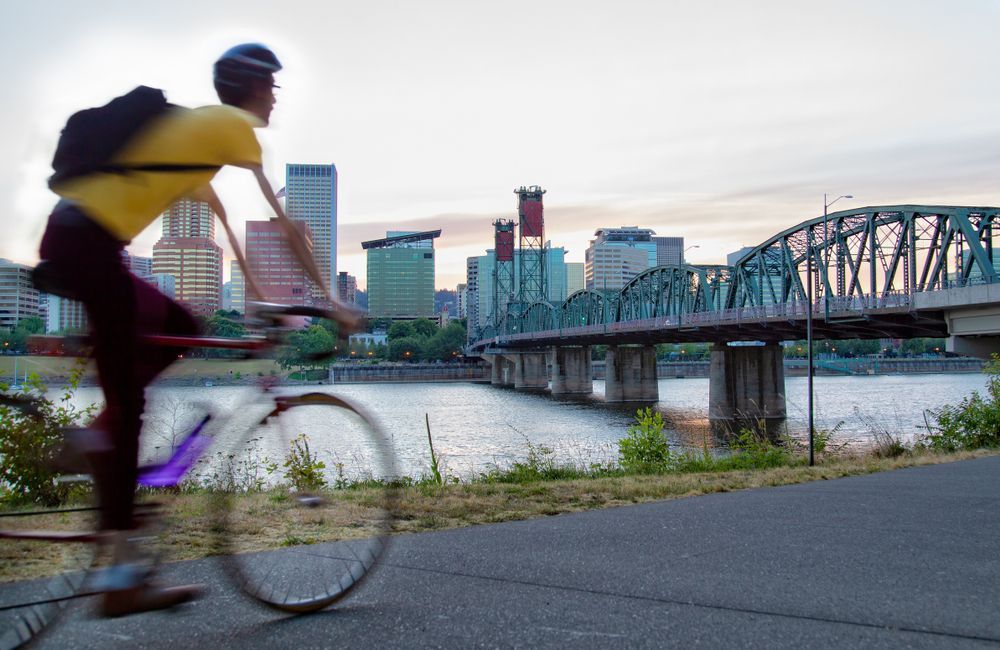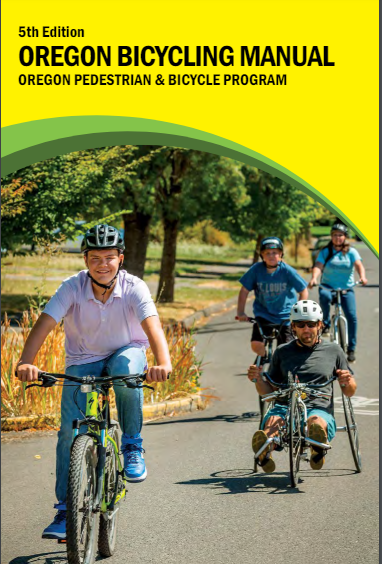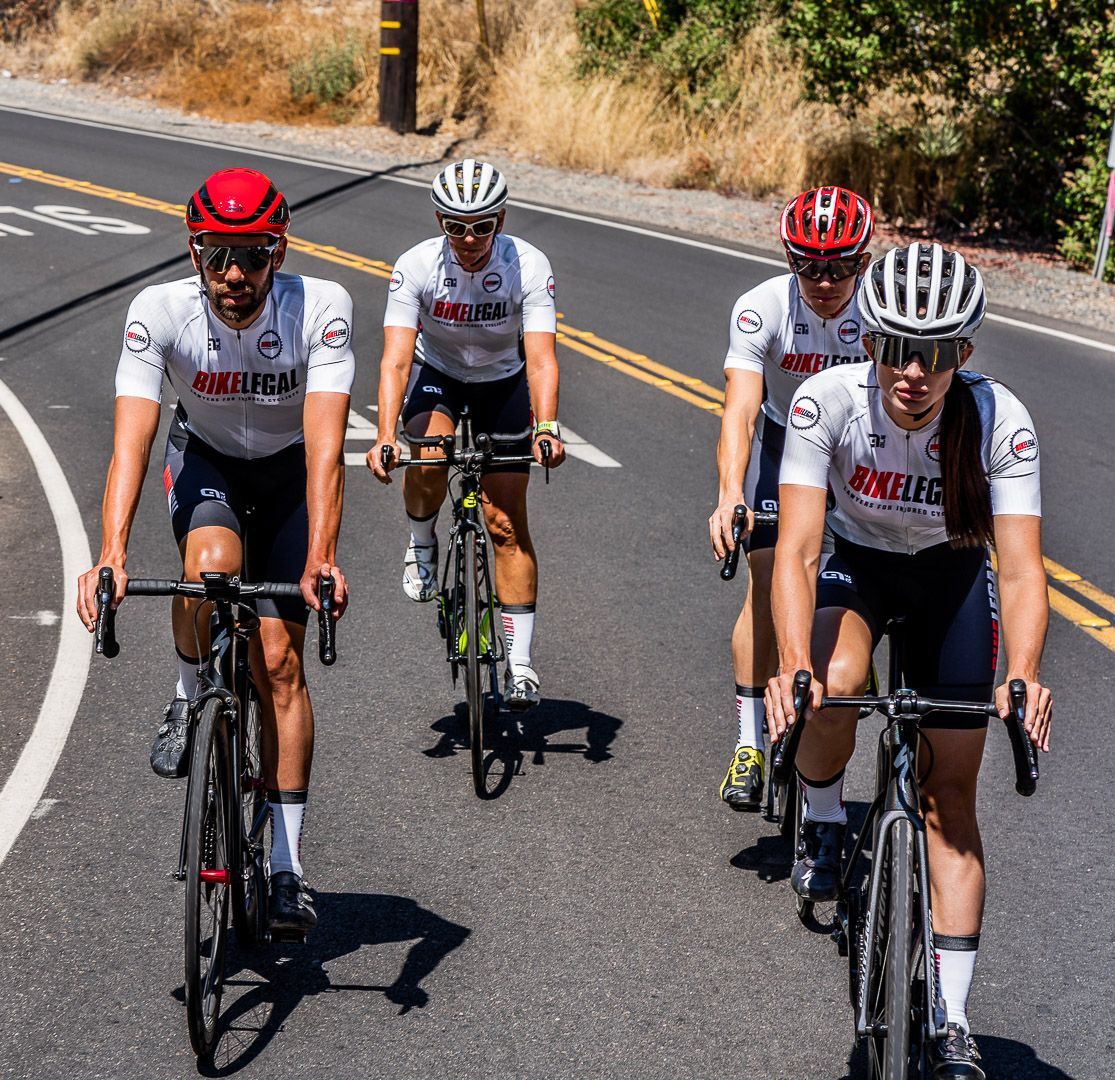Oregon Bicycle Accidents: Stats, Laws, and Tips
Follow us on
social media!

Navigating the roads as a cyclist means being well-informed and prepared. This guide dives into the crucial statistics on bicycle safety and laws in Oregon, providing you with all the essential knowledge.
Moreover, every cyclist must be aware of their rights and the resources available, especially if an accident occurs. Knowing about legal protections and support for cyclists in Oregon is a vital part of your safety toolkit, enabling you to ride confidently and securely.
In this guide, we’ll cover several key areas:
Benefits of Cycling in Oregon: Discover the perks like beautiful trails, supportive communities, and sustainable commuting options.
Challenges for Cyclists in Oregon: Tackle issues such as heavy traffic, varying road conditions, and areas lacking cycling infrastructure.
Bicycle Accident Statistics: Get up-to-date on the latest trends and data on bicycle accidents in Oregon.
Oregon’s Cycling Safety Ranking: See where Oregon stands in national safety rankings and delve into category-specific performances.
Safest Cities for Cyclists in Oregon: Focus on the top-rated cities for cyclist safety, with a detailed look at the best places to ride.
Importance of UM/UIM Coverage in Oregon: Understand the critical role of Uninsured/Underinsured Motorist coverage for cyclists.
Detailed State Bicycle Laws: Explore specific laws that affect cyclists in Oregon, including rules about passing safely and requirements for a person riding at night.
Cycling Advocacy Efforts in Oregon: Learn about the work of state and local advocacy groups dedicated to promoting cyclist rights and safety.
Essential Post-Accident Steps: Know the crucial actions to take if you're involved in a bicycle accident in Oregon.
Role of Bicycle Accident Attorneys: Understand the importance of specialized legal help in the event of cycling-related incidents.
Pros of Cycling in Oregon

Oregon is a paradise for cyclists, with numerous benefits that make it an attractive destination for both recreational riders and commuting cyclists. Here’s a closer look at what makes cycling in Oregon so rewarding:
Picturesque Routes: The very nature of Oregon features some of the most scenic cycling paths in the nation. Notable ones include the Historic Columbia River Highway State Trail, with its breathtaking waterfall views, and the Willamette Valley Scenic Bikeway, winding through the heart of Oregon’s wine country.
Dynamic Cycling Cultures: The cycling communities in Oregon are robust and lively. Cities like Portland and Eugene are hotspots for cycling activities, with events like the Portland Bridge Pedal and Eugene's Blackberry Bramble drawing cyclists together across the state.
Wellness Benefits: Riding your bike in Oregon is a great way to stay fit and clear your mind. Trails like the Sunriver Bike Path and Banks-Vernonia State Trail offer varied intensities for a physical workout in serene natural settings.
Green Commuting Options: Cycling is integral to Oregon’s green transportation initiatives. Portland, for example, is a leader in sustainable urban mobility, providing an extensive bicycle path and the popular Biketown bike-share program.
Developed Cycling Infrastructure: Oregon is dedicated to ensuring a safe and convenient cycling environment. The state features an extensive range of bike lanes, dedicated cycling paths, and specialized traffic solutions in cyclist-preferred cities like Portland and Bend, with ongoing efforts to improve and connect these facilities.
Moreover, understanding the legal rights of cyclists in Oregon can significantly enhance their experience. Firstly, it improves safety on the roads. By knowing the laws that apply to cyclists, individuals can navigate more confidently, ensuring their rides are both legal and secure.
Cons of Cycling in Oregon
While Oregon provides a stunning backdrop for cycling, those who pedal through its landscapes face distinct challenges that can affect their experience. Here’s a look into some specific obstacles that riders in Oregon may encounter:
Heavy Traffic in Urban Areas: In bike-friendly cities like Portland, cyclists often contend with heavy traffic. Congestion during rush hours can increase stress levels and the risk of accidents, making urban cycling less appealing.
Inconsistent Road Conditions: Many areas in Oregon boast well-maintained cycling paths, but some rural and less-traveled routes suffer from poor maintenance. Potholes, uneven surfaces, and debris can make these routes difficult to navigate and pose hazards to cyclists.
Limited Bicycle Infrastructure in Smaller Towns: While larger cities in Oregon have developed robust cycling infrastructure, towns like Coos Bay still lack comprehensive bike lanes and trails. This shortfall can deter daily bike commuting and compromise cyclist safety in these less urbanized areas.
Variable Weather Conditions: Oregon's climate is known for its unpredictable shifts, which can bring rain or chilly temperatures with little warning. These conditions can make cycling uncomfortable and, at times, risky, especially for those without the appropriate gear.
Challenging Terrain: Oregon’s varied topography, from the rolling Willamette Valley to the steep inclines of the Cascade Range, offers a mix of challenges. The rugged terrain can be particularly tough for novice cyclists or those without the right equipment.
Keep in mind that being informed and ready is crucial. By fully grasping and gearing up for these challenges, cyclists can confidently navigate Oregon's rich and diverse landscapes, transforming potential difficulties into exciting elements of their cycling adventures.
Bicycle Accident Statistics in Oregon
Exploring the hard statistics on cycling accidents in Oregon sheds light on the safety landscape for cyclists across the state. Here are some recent findings:
The 2021 Oregon Motor Vehicle Traffic Crashes report indicated a total of 454 bicycle or pedal cycle crashes.
The most recent non-pandemic year with complete data, 2019, saw 219 bicycle accidents reported in Portland alone, according to the Oregon Traffic Crash Summary (OTCS). Of these, 218 involved a collision with a moving vehicle.
The vast majority of bicycle crashes occur on city streets rather than highways. Specifically, only 13 bicycle crashes occurred on highways in the reported year, while a significant 94% took place on roads, including bikeways, with the remaining 6% happening on shoulders or sidewalks.
Here's a breakdown of the types of bicycle crashes in Oregon from the last ten years (updated to 2022):
Rear-end collisions make up the largest percentage at 30.2%.
Angle Collisions are also significant, comprising 25.6%.
Turning Movements are involved in 24.4% of accidents.
Head-on collisions account for 7.0%.
Sideswipe - Same-direction incidents occur in 5.8% of cases.
Sideswipe - Opposite Direction incidents represent 4.7%.
Other Types of crashes comprise 2.3%.
These statistics highlight the ongoing challenges and dangers faced by cyclists, particularly in urban areas of Oregon, and highlight the importance of continued efforts to improve road safety for cyclists.
Safe State Ranking for Cycling in Oregon
Oregon's commitment to cycling safety has earned it a high national ranking. Here's what the leaderboard says:
National Ranking: In the recent 2022 League of American Bicyclists' rankings, Oregon maintained the 2nd spot, consistently demonstrating a strong performance in fostering safe and accessible cycling conditions from 2019 to 2022.
Infrastructure & Funding: Oregon has been awarded a B+, reflecting a solid commitment to developing and maintaining cycling infrastructure.
Education & Encouragement: Achieved an A grade, showcasing strong initiatives to promote cycling and educate cyclists and motorists.
Traffic Laws & Practices: Also scored an A, indicating robust and effective regulations that enhance cycling safety.
Policies & Programs: Oregon received an A-, demonstrating strong governmental support for cycling initiatives.
Evaluation & Planning: Received an A, highlighting proactive and effective efforts in planning and evaluating cycling policies and infrastructure.
This comprehensive approach has propelled Oregon near the top of the national safety rankings, demonstrating a balanced focus on infrastructure and community support. However, the lower score in traffic laws and practices points to necessary areas of focus to ensure continuous improvement and maintain a top ranking in cycling safety.
Safe Cities Rankings in Oregon
Cyclist safety in Oregon varies significantly across different cities, with several cities standing out for their efforts to create a secure and friendly biking environment:
Portland: Portland scores 56 out of 100 in the large cities category for bike safety. Known for its progressive bike culture and extensive network of bike lanes, Portland continues to be a leader in urban cycling initiatives, despite facing challenges like heavy traffic and road-sharing with motor vehicles.
Corvallis: In the medium-sized cities category, Corvallis achieves a score of 63, making it one of the better places in Oregon for cyclists. Its commitment to maintaining safe cycling paths and promoting biking as a viable transportation option is reflected in its relatively high safety ranking.
Ashland: Ashland, listed among small cities, scores a 70. It's known for its scenic routes and cyclist-friendly policies. The city's small size contributes to less traffic and more enjoyable cycling experiences, coupled with dedicated efforts to enhance cyclist safety.
These cities not only exemplify proactive infrastructure development but boast commendable safety records, serving as models for other cities in Oregon. Their ongoing commitment to cyclist safety not only enhances accessibility but also ensures a better quality of cycling life for their residents.
Insurance: The Need for UM/UIM in Oregon
Oregon's bustling roadways underline the crucial need for Uninsured/Underinsured Motorist (UM/UIM) coverage for both drivers and cyclists. This insurance plays a vital role in providing financial protection against accidents involving drivers who are either uninsured or do not have adequate insurance.
Prevalence of Uninsured Drivers
In 2022, Oregon saw 12.3% of its drivers uninsured, placing it 24th nationally for the number of uninsured drivers. This highlights a significant exposure to risk for motorists and cyclists, as encountering an uninsured driver in Oregon is not uncommon.
Importance of UM/UIM Coverage
UM/UIM coverage is indispensable in Oregon. It acts as a safeguard against incidents involving uninsured drivers or those whose insurance cannot fully cover damages incurred. This coverage becomes crucial when the at-fault driver's insurance does not suffice to cover all resultant damages or medical costs.
Evaluating State Insurance Minimums
Oregon's legal requirement for insurance includes BI & PD Liability, Personal Injury Protection (PIP), UM, and UIM with minimum liability limits set at 25/50/20. These figures translate to up to $50,000 for all injuries per accident, with a maximum of $25,000 per individual, and $20,000 for property damage. These minimums, however, may prove inadequate in severe accidents due to high medical and repair costs.
Strategic Insurance Planning for Oregon Residents:
Ensure your insurance policy includes UM/UIM coverage as part of your regular insurance review. Adjust your coverage to adequately reflect the risks associated with Oregon roads.
Although UM/UIM coverage is required by law, consider increasing your limits for enhanced financial protection.
Consult with insurance experts to fully integrate UM/UIM coverage with your existing insurance plans, ensuring thorough protection against various road incidents.
Given the prevalence of uninsured drivers and the scenarios often encountered on Oregon's roads, opting for robust UM/UIM coverage is a strategic decision to safeguard against the financial implications of an accident with an uninsured or underinsured driver.
State Bicycle Laws in Oregon
In Oregon, bicycles are legally classified as vehicles according to Or. Rev. Stat. §§801.590; 814.400(2), affording cyclists the same rights and responsibilities as motorists, with some specific exceptions. Being aware of the Oregon revised statutes essential for cyclists to safely and effectively navigate the roads.
Cyclists need to be well-informed about the Oregon vehicle code to ensure they are cycling safely and within legal boundaries.
Safe Vehicle Passing Laws: Under Oregon law, motorists must pass cyclists by maintaining a safe distance, enough to prevent contact should the cyclist fall. This rule specifies that a "safe distance" is necessary if the motor vehicle is traveling at a speed less than 35 mph or the cyclist is turning left and the motorist passes on the right.
Helmet Law: Cyclists under the age of 16 are required to wear helmets, though the absence of a helmet cannot reduce compensation in the event of an accident. This applies to riders of motor-assisted scooters and electric-assisted bicycles as well.
Vulnerable Road User Laws: Increased penalties are applied to drivers who cause serious injury or death to vulnerable road users, including cyclists.
Distracted Driving Laws: The use of mobile communication devices while driving is prohibited, ensuring the safety of all road users, including those on bicycle paths or lanes.
Where to Ride: Cyclists should ride as close as practicable to the right curb or edge of the roadway, except when overtaking another vehicle, avoiding hazards, or preparing for a left turn.
Sidewalk Riding: Cyclists may use sidewalks, but must yield the right of way to pedestrians and provide an audible signal when overtaking. This rule ensures the normal and reasonable movement of all sidewalk users and accommodates scenarios where a vehicle overtaking the road may influence sidewalk usage.
Mandatory Use of Separated Facilities: Cyclists must use adjacent bicycle lanes or paths unless conditions make it unsafe or impractical, such as when overtaking vehicles, turning, or avoiding hazards.
Bicycling Under the Influence: It is illegal to operate a bicycle under the influence of intoxicants, with penalties similar to those for motorized vehicles.
"Idaho Stop" and Vehicle Detection Errors: Cyclists may proceed through stop signs after slowing to a safe speed and through red lights at intersections with malfunctioning vehicle detection devices, provided they yield the right and exercise due care.
Dooring Law: Opening vehicle doors into traffic must be done safely to avoid creating an immediate hazard, especially near a bicycle lane and pedestrian ramp.
E-bike Regulations: Electric-assisted bicycle may not exceed 20 MPH when powered by an electric motor but can go faster when propelled by human effort. Riders must be at least 16 years old, and while helmets are not mandated for riders over 16, wearing one is strongly recommended for safety.
Oregon's cycling regulations mandate that bicyclists adhere to the same rules as motor vehicles, which include stopping at stop signs and yielding the right of way to pedestrians.
However, it's vital to thoroughly understand the statewide traffic laws and local ordinances in Oregon to ensure you are well-prepared and safeguarded. This knowledge is key to safely managing the legal aspects and championing your rights as a cyclist.
State Advocacy Groups in Oregon
Oregon has a vibrant network of advocacy groups dedicated to enhancing the safety and rights of cyclists, playing a crucial role in shaping a more bike-friendly environment throughout the state.
Key advocacy groups include:
The Street Trust: This organization leads legislative advocacy and education to make cycling a safe and viable mode of transportation throughout Oregon. They engage in policy discussions and collaborate with government agencies to foster a bike-friendly environment.
Oregon Mountain Biking Coalition: Focused on the interests of mountain bikers, this coalition advocates for sustainable trail access, promotes responsible riding, and works to ensure that mountain biking trails and facilities meet the needs of the community.
Oregon Bicycle and Pedestrian Advisory Committee: This committee advises the state on issues affecting bicyclists and pedestrians, helping to shape policies that improve safety, accessibility, and connectivity in cycling and walking infrastructure.
In addition to these advocacy groups, Oregon has legal resources available to cyclists, especially important in the event of accidents. These resources play a critical role in navigating the complexities of Oregon's traffic laws, helping to secure fair treatment and justice for cyclists.
Major City Advocacy Groups in Oregon
In Oregon’s major cities, local advocacy groups play a crucial role in enhancing cyclist safety and promoting cycling rights. These organizations tackle unique challenges in urban cycling, advocating for better infrastructure and policy improvements tailored to each city’s specific needs.
Portland: Bike Portland stands out in Oregon's largest city, focusing on making Portland's streets safer for cyclists. The group actively engages in policy-making and hosts community-building events to foster a robust cycling culture.
Eugene: Greater Eugene Area Riders (GEARs) advocates for safer and more accessible cycling in Eugene. They work closely with city officials and community members to enhance the cycling infrastructure and promote cycling as a sustainable mode of transportation.
Salem: Salem Bicycle Club focuses on advocating for better cycling conditions in Salem. They organize rides and events that promote cycling, engage with local government to improve cycling infrastructure and educate the community on safe cycling practices.
Bend: Bend Bikes champions cycling initiatives in Central Oregon, particularly in Bend. They advocate for safe, connected, and accessible cycling infrastructure and work to influence policy decisions that benefit the cycling community.
These groups are deeply familiar with the cycling landscapes of their respective cities and are dedicated to making urban cycling a safer and more appealing option.
By addressing city-specific issues, they ensure that local cyclists’ needs are addressed and their voices amplified in the ongoing dialogue about urban planning and transportation.
What to Do If You've Been Involved in a Cycling Accident in Oregon?
If you find yourself involved in a bicycle accident in Oregon, it's crucial to know the appropriate steps to take to ensure your safety and protect your rights:
Ensure Your Safety and Call for Help: Immediately assess your physical condition. If you're injured, dial 9-1-1 for emergency services.
Exchange Information: Obtain the driver’s contact and insurance details with their vehicle identification number (VIN). It’s also helpful to collect contact information from any witnesses.
Document the Incident: Start documenting the accident as soon as you can. Take photographs of the scene, your bicycle, the vehicle involved, and any visible injuries you have sustained. Make notes on the accident details, including the time, location, and how the accident occurred.
Wait for Authorities: Do not leave the accident scene before the authorities arrive. A police report can be invaluable, particularly if the accident results in significant injuries or legal complications.
Refrain from Negotiations: Limit your interaction with the other party to the necessary information. Avoid discussing the accident details or admitting fault. Statements made at the scene can be misconstrued or used against you in legal settings.
Seek Medical Attention: Even if you feel fine, it's important to visit a healthcare provider after the accident. Some injuries, like concussions or internal injuries, may not be immediately apparent.
Following these steps can help you manage a difficult situation more effectively and ensure your rights are protected in the aftermath of a bicycle accident in Oregon.
Why You Need an Oregon Bicycle Accident Attorney?
Dealing with the consequences of a bicycle accident in Oregon can be intricate and demanding. Specialized legal representation is crucial to effectively manage the subtleties of bicycle accident cases and secure the compensation you deserve.
Here are several reasons why hiring an Oregon bicycle accident lawyer is essential:
Expertise in Local Laws: Oregon bicycle laws are specific and detailed. An experienced bike accident attorney will have in-depth knowledge of such bicycle laws and how they apply to your case, ensuring that all legal avenues are explored.
Dealing with Insurance Companies: Insurance companies often attempt to minimize payouts. A cycling attorney skilled in bicycle accident claims knows how to negotiate with these companies to achieve a fair settlement that covers all your medical expenses, lost wages, and other damages.
Establishing Liability: Proving liability in bicycle accidents can be complicated. An experienced bicycle accident lawyer can help gather the necessary evidence, such as traffic camera footage, witness statements, and accident reports, to build a strong case on your behalf.
Maximizing Your Compensation: A top-rated bicycle accident attorney knows how to accurately assess the full extent of your damages, including long-term medical costs, pain and suffering, and potential future losses. This ensures that the compensation you receive is commensurate with the impact of the accident.
Legal Representation in Court: If your case goes to court, having a lawyer with courtroom experience is invaluable. They can effectively represent your interests and argue your case, giving you the best chance of a favorable outcome.
Key Takeaways
Know Your Rights: Familiarize yourself with Oregon's bicycle laws to ensure safe and legal riding.
Appreciate the Benefits: Leverage the health, environmental, and community benefits of cycling in Oregon's scenic and active settings.
Prepare for Challenges: Be ready for Oregon's cycling challenges like variable weather and inconsistent road conditions.
Stay Updated on Statistics: Stay informed about bicycle safety data to understand risks and enhance your precautions.
Assess Safety Rankings: Recognize Oregon's high safety rankings and robust infrastructure, supporting a secure cycling environment.
Engage with Advocacy Groups: Connect with local advocacy groups to support safer cycling policies and community initiatives.
Ensure Adequate Insurance Coverage: Ensure you have adequate UM/UIM coverage to protect against uninsured drivers.
Follow Essential Post-Accident Steps: Know the essential steps to take immediately following a cycling accident to protect your rights.
Seek Legal Support when Needed: Understand the importance of having a specialized attorney for navigating post-accident legal challenges.
For cyclists involved in accidents in Oregon, securing the right legal representation is vital. Bike Legal offers access to experienced professionals and some of the best bicycle accident attorneys in Oregon, Our specialized expertise is precisely what you need to navigate these challenging circumstances.
Request a free consultation by calling 877-BIKE LEGAL (877 245-3534) or submitting a form.


